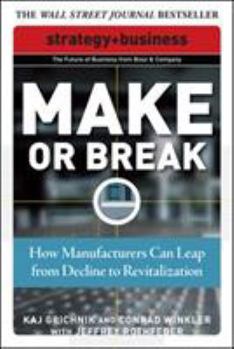Make or Break: How Manufacturers Can Leap from Decline to Revitalization
Break the manufacturing mold--and make new paths to phenomenal growth In a world of emerging markets, changing work forces, and accelerating innovation, manufacturing is once again a key corporate issue. Manufacturing expertise is a strategic competitive advantage, distinguishing winning companies (like Procter & Gamble, Lego, Toyota, Zara, and Tata) from those that have let their capabilities languish. It may not be easy to take...
Format:Paperback
Language:English
ISBN:0071508309
ISBN13:9780071508308
Release Date:April 2008
Publisher:McGraw-Hill Companies
Length:224 Pages
Weight:0.60 lbs.
Dimensions:0.6" x 6.5" x 8.3"
Customer Reviews
3 ratings
In sourcing is alive!
Published by Thriftbooks.com User , 14 years ago
Many US companies today are rethinking the outsourcing strategy. Manufacturing jobs in USA, have been down for the past forty years. GM filed bankruptcy, and millions lost jobs in the past 10 years. But statistics showed that in-sourcing (keep jobs in USA, move jobs from a high-cost labor to lower-cost labor state) is a good solution. Using automation, quality re-engineering, and many other means, will increase manufacturing jobs. This is a good book to understand these principles.
The future of manufacturing? There's "bad news" but also "good news"
Published by Thriftbooks.com User , 15 years ago
This is one of the volumes in "The Future of Business from Booz & Company" series in which the firm's senior-level executives explain especially significant developments and emerging trends within major sectors of the global marketplace. (Booz & Company is the new name for the commercial side of Booz Allen Hamilton.) In this instance, Kaj Grichnik and Conrad Winkler with Jeffrey Rothfeder focus on "the opportunities for manufacturing along with the perils [decision-makers] may face and the potential for overcoming them...[as well as] special trends that will affect manufacturing and the evolution of new production methods, techniques, philosophies, and strategies that could positively influence the performance of industry and improve global economic, environmental, and social conditions. We describe how current and future trends are conspiring to alter the dynamics of manufacturing, and explain how manufacturers can transform themselves to achieve success in a difficult landscape." All of the authors of volumes in this series have the full benefit of a wealth of resources that have been accumulated during the completion of Booz & Company's client assignments throughout the world. The specific observations and recommendations that Grichnik and Winkler offer are research-driven and based on real-world information. For example, they examine: How manufacturers have reached a "crossroads" of multiple options, with decisions to be made having "make or break" consequences (Chapter 1) Eight "very real" challenges that manufacturers now face and why they must learn to navigate them successfully; also, lessons to be learned by using an analytical model when playing out two scenarios that take entirely different approaches to manufacturing (Chapter 2) How Toyota's greatest advantage "has accrued from the way that a number of factors - some generated within the company, others external--have all, linked together in a virtuous cycle [i.e. each element contributing to the cycle makes the others move faster] while US auto makers have been caught up in a vicious cycle [i.e. problems cause each other to worsen more quickly than they can be managed individually]"; also, how to "harness" virtuous cycles and avoid vicious ones (Chapter 3) The four principles on which innumerable programs, tools, techniques. and tactics are based to make (rather than break) a company's relations with its workforce mutually beneficial; also, qualities that will support and enable the success of manufacturing executives (Chapter 4) Frankly, I find it remarkable that Grichnik and Winkler can somehow provide so much valuable information and counsel within only 207 pages. With rare precision, eloquence, and (yes) brevity, they explain why the future of manufacturing is truly becoming a "make-or-break" proposition for many companies as their weaknesses are increasingly exposed. "At the same time, there are always great opportunities in challenging times." More specifically, a
Rethink Manufacturing
Published by Thriftbooks.com User , 16 years ago
This short book challenges us to revisit the manufacturing function in our companies,and provides an action plan for doing so. The book teaches us why manufacturing must be integrated in--and not a stepchild of--the company's operation, even for those outsourced components. CEOs and all department heads must get together and discuss the strategies in this book.





